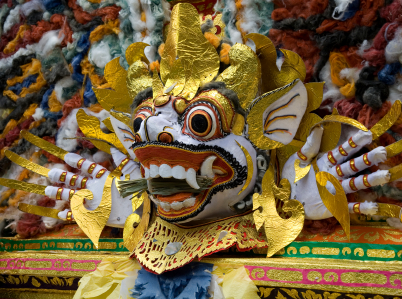Interviews with: Michael Dean, Arik Beatty, and Tich Mangono.
Arik Beatty
Arik is a student in John Emigh’s performance class, where he received a small background in Balinese masking. According to Arik, Balinese masking is very similar to Commedia Dell’ Arte. The actors portray archetypal characters in a variation of one central story that is never changed fundamentally, only given comtemporary settings.
Arik told me that the masks themselves were placed over the face with the mouth open for speaking roles. The masks are sometimes difficult to see out of and it could be inhibitory to the actor’s physicality. However, these Balinese masks are incredibly important to help the actor get into character.
I asked Arik if there was a ritual involved in putting on the mask and he told me that in class they used incense and water. They were never allowed to handle the mask with the left hand because of superstition surrounding the mask. Then they were all supposed to stare at the mask and let the character of it affect them, which is an important characteristic of archetypal masks (see Comedy and Tragedy). Arik told me that Balinese masks act on the actor to create the character. The mask dictates the character the actor is to assume.
I started asking a lot of questions about the inhibitory nature of the mask and how it forms an actor into the given character and Arik told me that although physically limiting, these masks open up incredible possibilities to play. He explained that as an actor, you have to talk to the mask and the mask talks back to you. These masks have an identity that they will communicate and will affect you if you let it.

Michael Dean
I interviewed Michael Dean over the course of a month and he provided a great resource. Michael has experience in clowning, Commedia Dell’ Arte, and many other kinds of masked performance. He told me that almost anything can be considered a mask, like a red clown’s nose could be considered the smallest mask. These masks, whether they affect the actor psychologically or physically, always dictate some sort of movement. Even a woman’s makeup dictates her movement to some degree. For example, according to Michael one of the first rules you learn with regard to masking is that you NEVER touch the mask. Women learn not to touch their face if they have makeup on. He also told me that the actor must always be conscious of the way in which the mask is viewed by the audience.
I think the most interesting thing he brought to my attention was that most actors, and indeed most women, assume that people must be able to see through their makeup, but they never do. This sets up the situation where the actor is trying to overcompensate with physicality to not be recognized by the audience. This fear helps add to the creation of a character.
Tich Mangono and Michael Dean
I had a small joint interview between Michael Dean and Ticha, an actor in Death and the King’s Horseman. Ticha played the most number of characters in Death. He played everything from a young woman to a military officer. He explained to me that the mask they used helped him with exploring the differences in gender. The mask was liberating for him. Although, it was physically constraining and he had to learn through lots of practice how to place it on his face and still be able to see properly.
